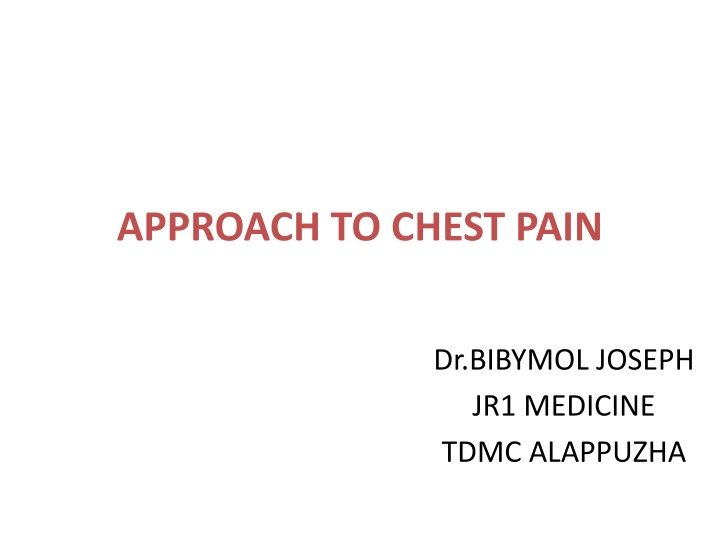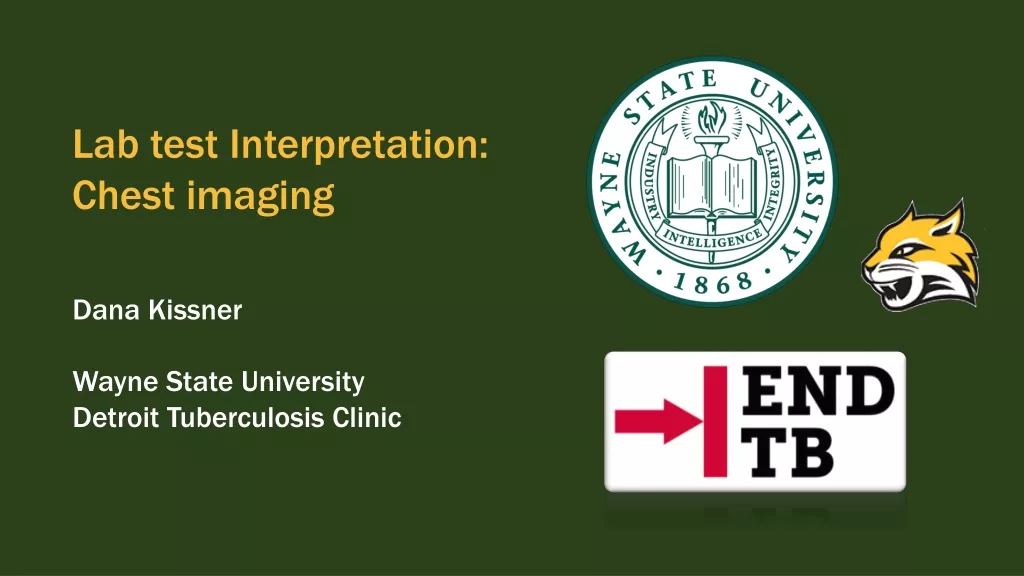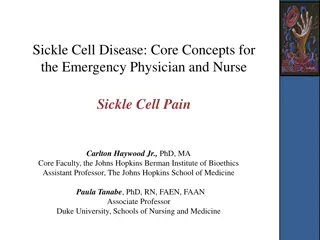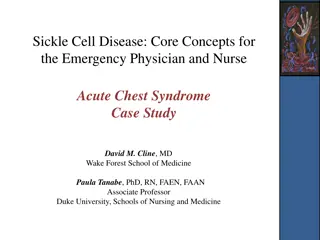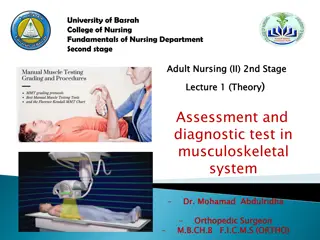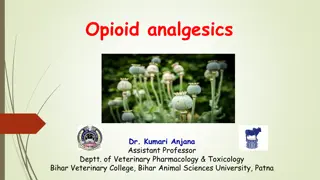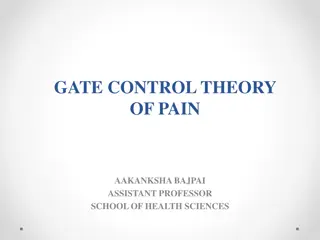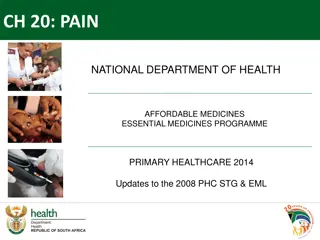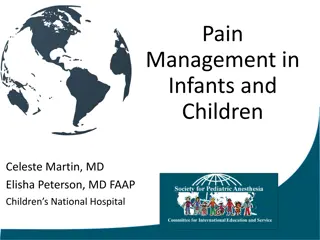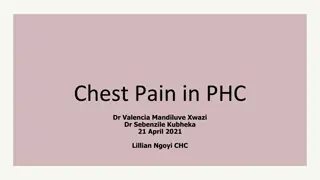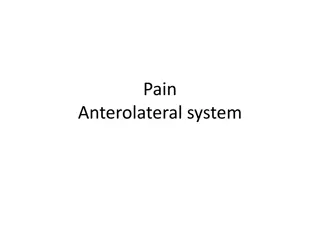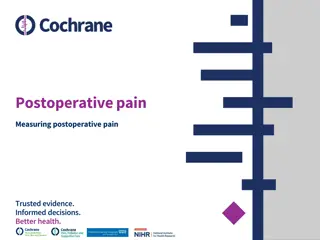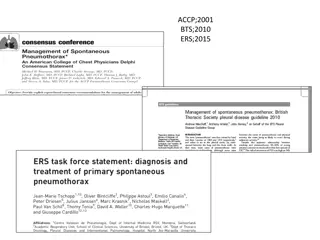Approach to Chest Pain Evaluation
Chest discomfort is a common reason for medical attention, presenting challenges in diagnosis due to various causes. Initial assessment focuses on myocardial ischemia, cardiopulmonary conditions, and non-cardiopulmonary causes, emphasizing identification of life-threatening conditions.
Download Presentation

Please find below an Image/Link to download the presentation.
The content on the website is provided AS IS for your information and personal use only. It may not be sold, licensed, or shared on other websites without obtaining consent from the author.If you encounter any issues during the download, it is possible that the publisher has removed the file from their server.
You are allowed to download the files provided on this website for personal or commercial use, subject to the condition that they are used lawfully. All files are the property of their respective owners.
The content on the website is provided AS IS for your information and personal use only. It may not be sold, licensed, or shared on other websites without obtaining consent from the author.
E N D
Presentation Transcript
APPROACH TO CHEST PAIN Dr.BIBYMOL JOSEPH JR1 MEDICINE TDMC ALAPPUZHA
Chest discomfort is among the most common reasons for which patients present for medical attention at ED or an OP clinic The evaluation of nontraumatic chest discomfort is inherently challenging owing to the broad variety of possible causes, a minority of which are life-threatening conditions that should not be missed. It is helpful to frame the initial diagnostic assessment and triage of patients with acute chest discomfort around three categories: (1) myocardial ischemia; (2) other cardiopulmonary causes (pericardial disease, aortic emergencies, and pulmonary conditions); (3) non-cardiopulmonary causes.
EPIDEMIOLOGY AND NATURAL HISTORY Chest discomfort is the third most common reason for visits to the ED More than 60 % of patients with this presentation are hospitalised for further testing 15% of evaluated patients are eventually diagnosed with ACS The most common diagnoses are gastrointestinal causes and fewer than 10% are other life- threatening cardiopulmonary conditions.
CAUSES OF CHEST DISCOMFORT Gastrointestinal 42% Ischemic heart disease 31% Chest wall syndrome 28% Pericarditis 4% Pleuritis 2% Pulmonary embolism 2% Lung cancer 1.5% Aortic aneurysm 1% Aortic stenosis 1% Herpes zoster 1%
MYOCARDIAL ISCHEMIA/INJURY Angina pectoris Myocardial ischemia is precipitated by an imbalance between myocardial oxygen requirements and myocardial oxygen supply, resulting in insufficient delivery of oxygen to meet the heart s metabolic demands. Myocardial oxygen consumption may be elevated by increases in heart rate, ventricular wall stress, and myocardial contractility, whereas myocardial oxygen supply is determined by coronary blood flow and coronary arterial oxygen content. When myocardial ischemia is sufficiently severe and prolonged in duration (as little as 20 min), irreversible cellular injury occurs, resulting in MI.
Ischemic heart disease is most commonly caused by atheromatous plaque that obstructs one or more of the epicardial coronary arteries. Stable ischemic heart disease usually results from the gradual atherosclerotic narrowing of the coronary arteries. Stable angina is characterized by ischemic episodes that are typically precipitated by a superimposed increase in oxygen demand during physical exertion and relieved upon resting.
Ischemic heart disease becomes unstable most commonly when rupture or erosion of one or more atherosclerotic lesions triggers coronary thrombosis. Unstable ischemic heart disease is classified clinically by the presence or absence of detectable myocardial injury and the presence or absence of ST-segment elevation on the patient s electrocardiogram (ECG).
When acute coronary atherothrombosis occurs, the intracoronary thrombus may be partially obstructive, generally leading to myocardial ischemia in the absence of ST-segment elevation. Marked by ischemic symptoms at rest, with minimal activity, or in an accelerating pattern, unstable ischemic heart disease is classified as unstable angina when there is no detectable myocardial injury and as non ST elevation MI (NSTEMI) when there is evidence of myocardial necrosis
When the coronary thrombus is acutely and completely occlusive, transmural myocardial ischemia usually ensues, with ST-segment elevation on the ECG and myocardial necrosis leading to a diagnosis of ST elevation MI (STEMI)
The term acute coronary syndrome which encompasses unstable angina, NSTEMI, and STEMI, is in general reserved for ischemia precipitated by acute coronary atherothrombosis. In order to guide therapeutic strategies, a standardized system for classification of MI has been expanded to discriminate MI resulting from acute coronary thrombosis (type 1) from MI occurring secondary to other imbalances of myocardial oxygen supply and demand (type 2)
Other contributors endothelial dysfunction, microvascular disease, and vasospasm. Non-atherosclerotic processes congenital abnormalities of the coronary vessels myocardial bridging coronary arteritis radiation-induced coronary disease Conditions associated with extreme myocardial oxygen demand and impaired endocardial blood flow aortic valve disease hypertrophic cardiomyopathy idiopathic dilated cardiomyopathy
MECHANISMS OF CARDIAC PAIN Ischemic episodes are thought to excite local chemosensitive and mechanoreceptive receptors that, in turn, stimulate release of adenosine, bradykinin, and other substances that activate the sensory ends of sympathetic and vagal afferent fibers. The afferent fibers traverse the nerves that connect to the upper five thoracic sympathetic ganglia and upper five distal thoracic roots of the spinal cord. From there, impulses are transmitted to the thalamus..
Within the spinal cord, cardiac sympathetic afferent impulses may converge with impulses from somatic thoracic structures, and this convergence may be the basis for referred cardiac pain. In addition, cardiac vagal afferent fibers synapse in the nucleus tractus solitarius of the medulla and then descend to the upper cervical spinothalamic tract, and this route may contribute to anginal pain experienced in the neck and jaw
OTHER CARDIOPULMONARY CAUSES PERICARDIAL DISEASES Inflammation of the pericardium due to infectious or noninfectious causes can be responsible for acute or chronic chest discomfort. The visceral surface and most of the parietal surface of the pericardium are insensitive to pain. Therefore, the pain of pericarditis is thought to arise principally from associated pleural inflammation. Because of this pleural association, the discomfort of pericarditis is usually pleuritic pain that is exacerbated by breathing, coughing, or changes in position.
Moreover, owing to the overlapping sensory supply of the central diaphragm via the phrenic nerve with somatic sensory fibers originating in the third to fifth cervical segments, the pain of pleural pericarditis is often referred to the shoulder and neck. Involvement of the pleural surface of the lateral diaphragm can lead to pain in the upper abdomen
MYOCARDIAL DISEASES Acute inflammatory and other non-ischemic myocardial diseases can also produce chest discomfort. The symptoms of Takotsubo (stress-related) cardiomyopathy often start abruptly with chest pain and shortness of breath. This form of cardiomyopathy, in its most recognizable form, is triggered by an emotionally or physically stressful event and may mimic acute MI because of its commonly associated ECG abnormalities, including ST-segment elevation, and elevated biomarkers of myocardial injury. The symptoms of acute myocarditis are highly varied. Chest discomfort may either originate with inflammatory injury of the myocardium or be due to severe increases in wall stress related to poor ventricular performance.
DISEASES OF THE AORTA Acute aortic dissection is a less common cause of chest discomfort but is important because of the catastrophic natural history . Acute aortic syndromes encompass a spectrum of acute aortic diseases related to disruption of the media of the aortic wall. 1. Aortic dissection involves a tear in the aortic intima, resulting in separation of the media and creation of a separate false lumen.
2. A penetrating ulcer has been described as ulceration of an aortic atheromatous plaque that extends through the intima and into the aortic media, with the potential to initiate an intramedial dissection or rupture into the adventitia. 3. Intramural hematoma is an aortic wall hematoma with no demonstrable intimal flap, no radiologically apparent intimal tear, and no false lumen. Intramural hematoma can occur due to either rupture of the vasa vasorum or, less commonly, a penetrating ulcer.
Each of these subtypes of acute aortic syndrome typically presents with chest discomfort that is often severe, sudden in onset, and sometimes described as tearing in quality. Acute aortic syndromes involving the ascending aorta tend to cause pain in the midline of the anterior chest, whereas syndromes most often present with pain in the back. Therefore, dissections that begin in the ascending aorta and extend to the descending aorta tend to cause pain in the front of the chest that extends toward the back, between the shoulder blades. descending aortic
Proximal aortic dissections that involve the ascending aorta (type A in the Stanford nomenclature) are at high risk for major complications that may influence the clinical presentation (1) compromise of the aortic ostia of the coronary arteries, resulting in MI; (2) disruption of the aortic valve, causing acute aortic insufficiency (3) rupture of the hematoma into the pericardial space, leading to pericardial tamponade.
Acute aortic syndromes are relatively uncommon group of disorders(annual incidence 3 per 100,000 population) Non-traumatic aortic dissections are associated with hypertension or conditions associated with deterioration of the elastic or muscular components of the aortic media, including pregnancy, bicuspid aortic disease or inherited connective tissue diseases, such as Marfan and Ehlers-Danlos syndromes.
Although aortic aneurysms are most often asymptomatic, thoracic aortic aneurysms can cause chest pain and other symptoms by compressing adjacent structures. This pain tends to be steady, deep, and occasionally severe. Aortitis, whether of noninfectious or infectious etiology, in the absence of aortic dissection is a rare cause of chest or back discomfort.
PULMONARY CONDITIONS Pulmonary and pulmonary-vascular conditions that cause chest discomfort usually do so in conjunction with dyspnea and often produce symptoms that have a pleuritic nature.
PULMONARY EMBOLISM Pulmonary emboli (annual incidence, ~1 per 1000) can produce dyspnea and chest discomfort that is sudden in onset. Typically pleuritic in pattern The chest discomfort associated with pulmonary embolism may result from (1) involvement of the pleural surface of the lung adjacent to a resultant pulmonary infarction (2) distention of the pulmonary artery (3) possibly,right ventricular wall stress and/or subendocardial ischemia pulmonary hypertension. related to acute
The pain associated with small pulmonary emboli is often lateral and pleuritic and is believed to be related to the first of these three possible mechanisms. In contrast, massive pulmonary emboli may cause severe substernal pain that may mimic an MI and that is plausibly attributed to the second and third of these potential mechanisms. Massive or submassive pulmonary embolism may also be associated with syncope, hypotension, and signs of right heart failure.
PNEUMOTHORAX Primary spontaneous pneumothorax is a rare cause of chest discomfort, with an estimated annual incidence in 7 per 100,000 among men and <2 per 100,000 among women. Risk factors include male sex, smoking, family history, and Marfan syndrome. The symptoms are usually sudden in onset, and dyspnea may be mild; thus, presentation to medical attention is sometimes delayed.
Secondary spontaneous pneumothorax may occur in patients with underlying lung disorders, such as chronic obstructive pulmonary disease, asthma, or cystic fibrosis, and usually produces symptoms that are more severe. Tension pneumothorax is a medical emergency caused by trapped intrathoracic air that precipitates hemodynamic collapse.
PARENCHYMAL,PLEURAL OR VASCULAR Most pulmonary diseases that produce chest pain, including pneumonia and malignancy, do so because of involvement of the pleura or surrounding structures. Pleurisy is typically described as a knifelike pain that is worsened by inspiration or coughing. In contrast, chronic pulmonary hypertension can manifest as chest pain that may be very similar to angina in its characteristics, suggesting right ventricular myocardial ischemia in some cases. Reactive airways diseases similarly can cause chest tightness associated with breathlessness rather than pleurisy
NON CARDIO PULMONARY CAUSES GI CONDITIONS Gastrointestinal disorders are the most common cause of nontraumatic chest discomfort and often produce symptoms that are difficult to discern from more serious causes of chest pain, including myocardial ischemia. Esophageal disorders, in particular, may simulate angina in the character and location of the pain. Gastroesophageal reflux and disorders of esophageal motility are common and should be considered in the differential diagnosis of chest pain
Acid reflux often causes a burning discomfort. The pain of esophageal spasm, in contrast, is commonly an intense, squeezing discomfort that is retrosternal in location and, like angina, may be relieved by nitroglycerin calcium channel antagonists. Chest pain can also result from injury to the esophagus, such as a Mallory-Weiss tear or even an esophageal rupture (Boerhaave syndrome) caused by severe vomiting. Peptic ulcer disease is most commonly epigastric in location but can radiate into the chest or dihydropyridine
Hepatobiliary disorders, including cholecystitis and biliary colic, may mimic acute cardiopulmonary diseases. Although the disorders usually localizes to the right upper quadrant of the abdomen, it is variable and may be felt in the epigastrium and radiate to the back and lower chest. This discomfort is sometimes referred to the scapula or may in rare cases be felt in the shoulder, suggesting diaphragmatic irritation. The pain is steady, usually lasts several hours, and subsides spontaneously, without symptoms between attacks. Pain resulting from pancreatitis is typically aching epigastric pain that radiates to the back. pain arising from these
MUSCULOSKELETAL AND OTHER CAUSES Chest discomfort can be produced by any musculoskeletal disorder involving the chest wall or the nerves of the chest wall, neck, or upper limbs. Costochondritis causing costochondral junctions (Tietze s syndrome) is relatively common. Cervical radiculitis may manifest as a prolonged or constant aching discomfort in the upper chest and limbs. The pain may be exacerbated by motion of the neck. tenderness of the
Occasionally, chest pain can be caused by compression of the brachial plexus by the cervical ribs, and tendinitis or bursitis involving the left shoulder may mimic the radiation of angina. Pain in a dermatomal distribution can also be caused by cramping of intercostal muscles or by herpes zoster
EMOTIONAL AND PSYCHIATRIC CONDITIONS As many as 10% of patients who present to EDs with acute chest discomfort have a panic disorder or related condition The symptoms may include chest tightness or aching that is associated with a sense of anxiety and difficulty in breathing. The symptoms may be prolonged or fleeting.
In nontraumatic chest discomfort, the priorities of the initial clinical assessment of (1) the patient s clinical stability (2) the probability that the patient has an underlying cause of the discomfort that may be life-threatening. patients who present with acute encounter include
The high-risk conditions of principal including ACS, acute aortic embolism, tension pneumothorax, with tamponade and esophageal rupture Patients with these conditions may deteriorate rapidly despite initially appearing well. The remaining population cardiopulmonary conditions favorable prognosis during completion of the diagnostic work-up. syndrome, pulmonary pericarditis with non- more has a
ASSESMENT OF A PATIENT WITH CHEST DISCOMFORT
HISTORY QUALITY OF PAIN Pressure or tightness- MI Pleuritic d/s pleura, pericarditis, PE, pul.parenchymal processes Tearing or ripping acute aortic dissection Burning acid reflux Squeezing- esophageal spasm
LOCATION OF DISCOMFORT Substernal location + radiation to neck,jaw,shoulder,arms MI Retrosternal esophageal pain Severe pain radiating to back, b/w shoulder blades- a/c aortic syndrome Radiation to trapezius ridge pericardial pain Hghly localised pai-tip of finger-unusual for angina
PATTERN MI- builds over mins, exacerbrated by activity, mitigated by rest AD,PE,spontaneous pneumotorax- pain reaches peak intensity immediately
PROVOKING AND ALLEVIATING FACTORS MI- prefer to rest, sit / stop walking warm up angina Pericarditis worse in supine, relieved sitting upright and leaning forward GERD- incr. by alcohol,reclined postion, dec in sitting.
PUD- exacerbration by eating, 60-90 min after meals Severe coronary atherosclerosis-can trigger postprandial angina Relief with Nitroglycerin- MI, esophageal spasm
ASSOCIATED SYMPTOMS MI- diaphoresis, dyspnea, nausea, fatigue, faintness,eructation PE- resp distress, hemoptysis, syncope Syncope or presyncope PE,AD,ischemic arrythmias Gi nausea,vomiting
PAST MEDICAL HISTORY Risk factors- atherosclerosis, venous thromboembolism Predisposing conditions- history of connective tissue diseases such as Marfans syndrome Depression/prior panic attacks
PHYSICAL EXAMINATION GENERAL Appearance severity of illness Acute MI anxious ,uncomfortable,pale, cyanotic or diaphoretic Levine s sign Body habitus young ,tall man with spontaneous pneumothorax
VITALS Significant tachycardia and hypotension acute MI with cardiogenic shock, massive pulmonary embolism, pericarditis with tamponade, or tension pneumothorax. Severe hypertension acute aortic emergencies can also present with profound hypotension when there is coronary arterial compromise or dissection into the pericardium
